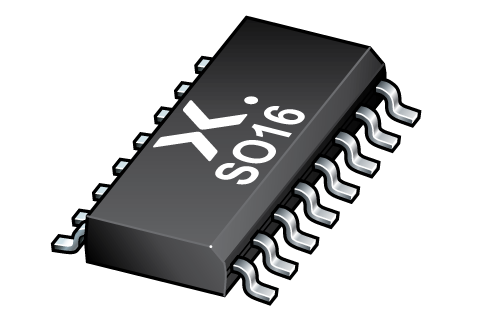可订购部件
| 型号 | 可订购的器件编号 | 订购代码(12NC) | 封装 | 从经销商处购买 |
|---|---|---|---|---|
| 74HC423D-Q100 | 74HC423D-Q100J | 935691586118 | SOT109-1 | 订单产品 |
试用我们种类齐全的评估板,体验我们的设备及其性能。深入了解我们的产品如何助您提高效率、稳健性和可靠性,让您的应用大受裨益。您可以在这里找到聚焦在应用、封装和不同的 Nexperia 产品的评估板。

Register once, drag and drop ECAD models into your CAD tool and speed up your design.
Click here for more informationDual retriggerable monostable multivibrator with reset
The 74HC423-Q100 is a dual retriggerable monostable multivibrator with output pulse width control by two methods. The basic pulse time is programmed by selection of an external resistor (REXT) and capacitor (CEXT). Once triggered, the basic output pulse width may be extended by retriggering (nA) or (nB). By repeating this process, the output pulse period (nQ = HIGH, nQ = LOW) can be made as long as desired. When nRD is LOW, it forces the nQ output LOW, the nQ output HIGH and also inhibits the triggering. Schmitt-trigger action in the nA and nB inputs, makes the circuit highly tolerant to slower input rise and fall times. The '423' is identical to the '123' but cannot be triggered via the reset input. Inputs include clamp diodes. This enables the use of current limiting resistors to interface inputs to voltages in excess of VCC.
This product has been qualified to the Automotive Electronics Council (AEC) standard Q100 (Grade 1) and is suitable for use in automotive applications.
Specified from -40 °C to +85 °C and from -40 °C to +125 °C
DC triggered from active HIGH or active LOW inputs
Retriggerable for very long pulses up to 100 % duty factor
Direct reset terminates output pulse
Schmitt-trigger action on all inputs except for the reset input
Wide supply voltage range from 2.0 V to 6.0 V
CMOS low power dissipation
High noise immunity
Latch-up performance exceeds 100 mA per JESD 78 Class II Level B
Complies with JEDEC standard no. 7A
CMOS input level
HBM: ANSI/ESDA/JEDEC JS-001 class 2 exceeds 2000 V
CDM: ANSI/ESDA/JEDEC JS-002 class C3 exceeds 1000 V
| 型号 | VCC (V) | Logic switching levels | Output drive capability (mA) | tpd (ns) | Power dissipation considerations | Tamb (°C) | Rth(j-a) (K/W) | Ψth(j-top) (K/W) | Rth(j-c) (K/W) | Package name |
|---|---|---|---|---|---|---|---|---|---|---|
| 74HC423D-Q100 | 2.0 - 6.0 | CMOS | ± 5.2 | 23 | low | -40~125 | 77 | 2.8 | 35 | SO16 |
| 型号 | 可订购的器件编号,(订购码(12NC)) | 状态 | 标示 | 封装 | 外形图 | 回流焊/波峰焊 | 包装 |
|---|---|---|---|---|---|---|---|
| 74HC423D-Q100 | 74HC423D-Q100J (935691586118) |
Active | 74HC423D |

SO16 (SOT109-1) |
SOT109-1 |
SO-SOJ-REFLOW
SO-SOJ-WAVE WAVE_BG-BD-1 |
SOT109-1_118 |
| 文件名称 | 标题 | 类型 | 日期 |
|---|---|---|---|
| 74HC423_Q100 | Dual retriggerable monostable multivibrator with reset | Data sheet | 2024-03-13 |
| AN90063 | Questions about package outline drawings | Application note | 2025-03-12 |
| SOT109-1 | 3D model for products with SOT109-1 package | Design support | 2020-01-22 |
| Nexperia_package_poster | Nexperia package poster | Leaflet | 2020-05-15 |
| SO16_SOT109-1_mk | plastic, small outline package; 16 leads; 1.27 mm pitch; 9.9 mm x 3.9 mm x 1.35 mm body | Marcom graphics | 2017-01-28 |
| SOT109-1 | plastic, small outline package; 16 leads; 1.27 mm pitch; 9.9 mm x 3.9 mm x 1.75 mm body | Package information | 2023-11-07 |
| SOT109-1_118 | SO16; Reel pack for SMD, 13"; Q1/T1 product orientation | Packing information | 2024-02-19 |
| 74HC423D-Q100_Nexperia_Product_Reliability | 74HC423D-Q100 Nexperia Product Reliability | Quality document | 2025-03-20 |
| SO-SOJ-REFLOW | Footprint for reflow soldering | Reflow soldering | 2009-10-08 |
| SO-SOJ-WAVE | Footprint for wave soldering | Wave soldering | 2009-10-08 |
| WAVE_BG-BD-1 | Wave soldering profile | Wave soldering | 2021-09-08 |
The Nexperia Longevity Program is aimed to provide our customers information from time to time about the expected time that our products can be ordered. The NLP is reviewed and updated regularly by our Executive Management Team. View our longevity program here.
| 文件名称 | 标题 | 类型 | 日期 |
|---|---|---|---|
| SOT109-1 | 3D model for products with SOT109-1 package | Design support | 2020-01-22 |
| 型号 | Orderable part number | Ordering code (12NC) | 状态 | 包装 | Packing Quantity | 在线购买 |
|---|---|---|---|---|---|---|
| 74HC423D-Q100 | 74HC423D-Q100J | 935691586118 | Active | SOT109-1_118 | 2,500 |
|
作为 Nexperia 的客户,您可以通过我们的销售机构订购样品。
如果您没有 Nexperia 的直接账户,我们的全球和地区分销商网络可为您提供 Nexperia 样品支持。查看官方经销商列表。
The interactive datasheets are based on the Nexperia MOSFET precision electrothermal models. With our interactive datasheets you can simply specify your own conditions interactively. Start by changing the values of the conditions. You can do this by using the sliders in the condition fields. By dragging the sliders you will see how the MOSFET will perform at the new conditions set.